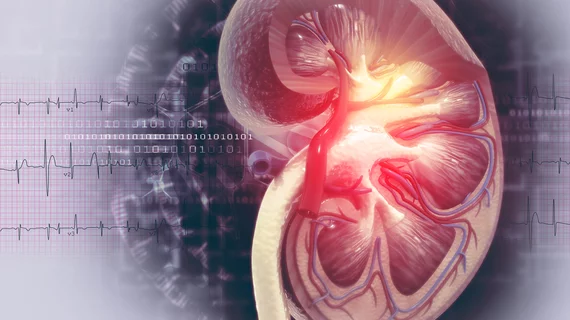Angiography, PCI improve outcomes in non-STEMI patients with kidney disease
Chronic kidney disease is a marker of adverse outcomes in patients with non-ST-elevation myocardial infarction (non-STEMI), according to a study published this month in the American Journal of Cardiology. And even though percutaneous coronary intervention (PCI) and coronary angiography (CAG) are linked to improved outcomes in those patients, they’re also drastically underutilized in clinical practice.
The paper, penned by Jeff Murray, MD, and colleagues in the Division of Cardiology at Creighton University, Omaha, Nebraska, assessed trends in the utilization of CAG, PCI and coronary artery bypass grafting (CABG) in non-STEMI patients enrolled in the National Inpatient Sample (NIS) database. The authors focused on outcomes in relation to patients’ kidney function, since chronic kidney disease (CKD) is a well-established independent risk factor for developing CVD.
“About 40 percent of patients with acute coronary syndrome (ACS) have renal dysfunction, and CKD nearly doubles mortality in patients with acute coronary syndromes,” Murray et al. wrote in AJC. “In addition to a higher burden of risk factors and comorbidities, underutilization of standard guideline-recommended medical and reperfusion therapies, including CAG and PCI, contributes to a higher morbidity and mortality in CKD patients with ACS.”
The team identified more than three million non-STEMI admissions in the NIS database between 2001 and 2012. A little more than half of patients with normal renal function underwent CAG—a statistic that was similar for PCI procedures. Patients with CKD who required renal replacement therapy (RRT) underwent CAG 45.9 percent of the time, while CKD patients not on RRT had CAG 36.1 percent of the time.
“Our study depicted considerably higher use of invasive procedures such as CAG and PCI in CKD patients on RRT compared to those who were not,” Murray et al. said. “This finding implies that concern regarding progression of CKD due to contrast-induced nephropathy was an important factor in determining the use of an invasive strategy.”
The authors said in-hospital mortality was higher in patients with CKD than in those without, and highest in CKD patients requiring RRT. In a propensity-matched cohort, CKD was linked to a boost in in-hospital mortality, acute kidney injury, hospital costs and length of stay. PCI was associated with decreased mortality across the board.
Murray and his team wrote rates of CAG and PCI use did increase “considerably” across all groups over the study period, but both procedures remain underused, especially in patients with concurrent CKD.
“While CAG and PCI were associated with improved outcomes, they remain underutilized in these patients,” the authors said.

